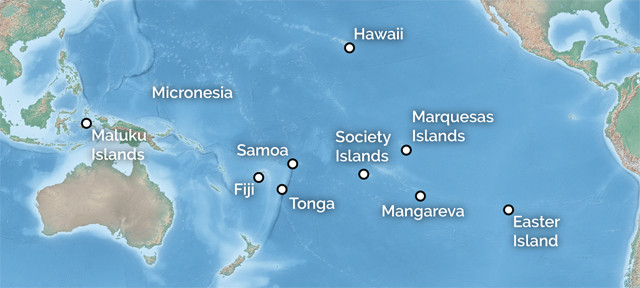
by Mary Caperton Morton Thursday, February 9, 2017

Credit: K. Cantner, AGI.
Even with modern airplanes and ships, the far-flung islands of Tonga, Samoa, Hawaii, Micronesia and Fiji are difficult to reach. Thousands of years ago, the seafarers who first settled the islands had a much more arduous journey, sailing thousands of kilometers and navigating by the stars. According to a new study, these intrepid travelers may have gotten a boost from weather associated with El Niño-Southern Oscillation patterns, which sweep through the Pacific every three to seven years.
During El Niño years, winds and storms in the Pacific shift from primarily westerly to easterly, creating more favorable travel for those heading from already settled islands toward the remote islands of Oceania. “Through time, Pacific Islanders should have developed a great deal of knowledge of different climatic variations, different oscillations of wind and changes in environments that would have influenced their survivability and their abilities to go to certain places,” said co-author Scott Fitzpatrick of the University of Oregon in a statement.
Using computer simulations, and climate data describing wind, ocean currents and precipitation patterns, Fitzpatrick’s team analyzed potential routes across the Pacific. The simulations, reported in Proceedings of the National Academy of Sciences, identified the most likely points of departure and the paths of least resistance — with favorable winds, currents and island waypoints along the way.
They found that the first inhabitants of western Micronesia probably came from near the Maluku (Spice) Islands and that Samoa was the most likely staging area for colonizing East Polynesia. Their models also indicated that Hawaii and New Zealand may have been settled from the Marquesas or Society Islands, and Easter Island may have been settled from the Marquesas or Mangareva. Some of the team’s findings are supported by archaeological evidence, while others challenge current theories of Pacific migration, Fitzpatrick and colleagues wrote.
Still unclear is the ultimate question plaguing Pacific archaeologists: Why would people set sail for unknown islands up to 4,000 kilometers away? “Was it political? Was it a result of population pressure?” Fitzpatrick said. “There were probably multiple reasons why people decided to leave one place and go to another.”
© 2008-2021. All rights reserved. Any copying, redistribution or retransmission of any of the contents of this service without the expressed written permission of the American Geosciences Institute is expressly prohibited. Click here for all copyright requests.